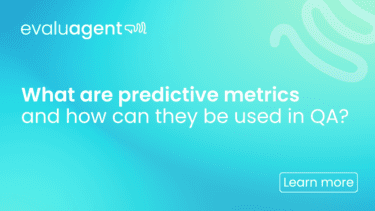What are predictive metrics and how can they be used in QA?


The contact center is now at a pivotal point. It’s evolving into a dynamic hub of innovation, personalization, and customer intelligence thanks to advanced reporting, automation, and predictive metrics.
But predictive metrics aren’t just transforming the way businesses measure performance – they’re also influencing the fundamental role of contact centers. In this blog, we explore how these technologies are revolutionizing customer interactions, employee roles, and the broader operational landscape.
At their core, predictive metrics are educated guesses about future outcomes. But before you dismiss these ‘guesses’ as lacking in value, there’s a bit more to it. These predictions are rooted in data analysis and validated against real-world results, making them especially valuable in situations where real-time data is scarce or expensive to obtain.
Predictive metrics enable a deeper understanding of customer needs and preferences. evaluagent’s own xNPS metric (Expected Net Promoter Scores) predicts scores for every customer interaction with over 85% accuracy, so businesses can overcome the limitations of traditional surveys, which typically achieve a mere 3% response rate. That means you can get actionable insights into the remaining 97% of customer interactions – including those that may signal churn or upsell opportunities.
See the value now? That’s just the beginning. The potential of predictive metrics extends far beyond analytics – they are reshaping the very essence of how contact centers operate.
Imagine a future where every customer interaction with a contact center is uniquely tailored.
Predictive metrics are paving the way for hyper-personalization, starting with the ability to anticipate customer preferences. Some customers may prefer immediate access to a human agent, while others are more comfortable interacting with conversational AI or self-service options.
By analyzing historical interactions and preferences, predictive metrics enable you to optimize routing, ensuring customers are matched with their preferred method of engagement. This leads to faster resolutions, higher satisfaction, and an experience that helps your customers feel heard and valued.
Historically, agents have played the role of generalists, handling a wide variety of queries, systems and technologies. As conversational AI takes on simpler tasks, agents are turning their talents to more complex, high-stakes interactions.
Predictive analytics can adjust for the difficulty of a conversation, accounting for factors like customer sentiment or how complex it was to reach a resolution. Such adjustments ensure that agents are judged not just by outcomes, but also the challenges they faced in achieving them.
Beyond evaluation, predictive metrics also enable aptitude forecasting. By analyzing performance trends, managers can identify agents with potential for leadership or specialization, as well as those who may need additional coaching.
With interactions becoming increasingly complex, it’s time to position agents as highly skilled professionals, rather than transactional operators. Predictive metrics and analytics help you do just that.
Quality assurance (QA) teams have traditionally spent countless hours on routine tasks like scoring agent performance and ensuring compliance. With automation on the rise, QA professionals are now free to focus on higher-value activities.
With plenty of data at their fingertips, QA teams can delve into predictive insights and uncover customer trends. They can identify friction points, recommend operational improvements and show the value of the contact center to the wider business.
This evolution from compliance-focused roles to strategic contributors really underscores the potential of predictive metrics, entirely transforming how your contact center is seen by the wider business.
Conversational AI, from chatbots to voice bots, has become a cornerstone of modern contact centers. However, the effectiveness of these systems often hinges on the quality of their training data. Predictive metrics can overhaul this by isolating and modeling the behaviors of top-performing agents, ensuring that AI systems provide responses based on your star players.
Moreover, predictive metrics are enabling human QA teams to play a direct role in training AI systems. By acting as mentors to AI, your team can guide improvements and ensure that automated interactions align with customer expectations.
And with agentic AI on the horizon – where virtual assistants will’ talk’ to virtual agents – monitoring will become more important than ever. Predictive metrics will have a role to play here too, identifying potential issues before they happen and using information from interactions to project future customer behaviors.
Predictive metrics are more than just a tool for analysis – they’re bringing the future of the contact center ever closer.
By enabling personalization, redefining agent roles, transforming QA teams, enhancing AI, and preparing for a post-human landscape, these metrics have the potential to influence every aspect of customer engagement.
And if you start embracing predictive metrics today, you’ll be well-positioned to blaze the trail of leading customer experiences of tomorrow.

Watch our Contact Center Performance Summit to see our Product Director talk about predictive metrics, as well as other leading experts on AI, CX, and more!
Watch talks now